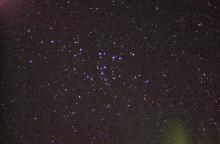Listen to today's episode of StarDate on the web the same day it airs in high-quality streaming audio without any extra ads or announcements. Choose a $8 one-month pass, or listen every day for a year for just $30.
You are here
Close Clusters
The Milky Way galaxy is home to about 160 globular clusters — ball-shaped collections of hundreds of thousands of stars. They’re spread all over. So it’s rare to see two of them close together in the sky.
Two that appear quite close to each other are high in the sky this evening, in Coma Berenices. M53 is easily visible through binoculars, while its companion, NGC 5053, is fainter. They’re separated by less than the width of your finger held at arm’s length.
NGC 5053 is about 54,000 light-years from Earth, with M53 a few thousand light-years farther. That closeness suggests the two clusters may be linked in some way. In fact, one set of observations detected a “bridge” of stars between them — stars that could have been pulled into space when the two clusters passed especially close together. Other studies have seen “tails” of stars but no bridge, so it’s not certain that the clusters have interacted with each other.
Researchers have also suggested that one or both clusters might belong to a dwarf galaxy that the Milky Way is gobbling up.
Some recent studies argue against that idea, though. For one thing, the chemistry of the stars in the clusters is a pretty good match for those in the Milky Way. And for another, the orbit of NGC 5053 doesn’t seem to match that of the dwarf galaxy. So the clusters may have been born with the Milky Way after all — two siblings that are high in the east at nightfall.
Script by Damond Benningfield





